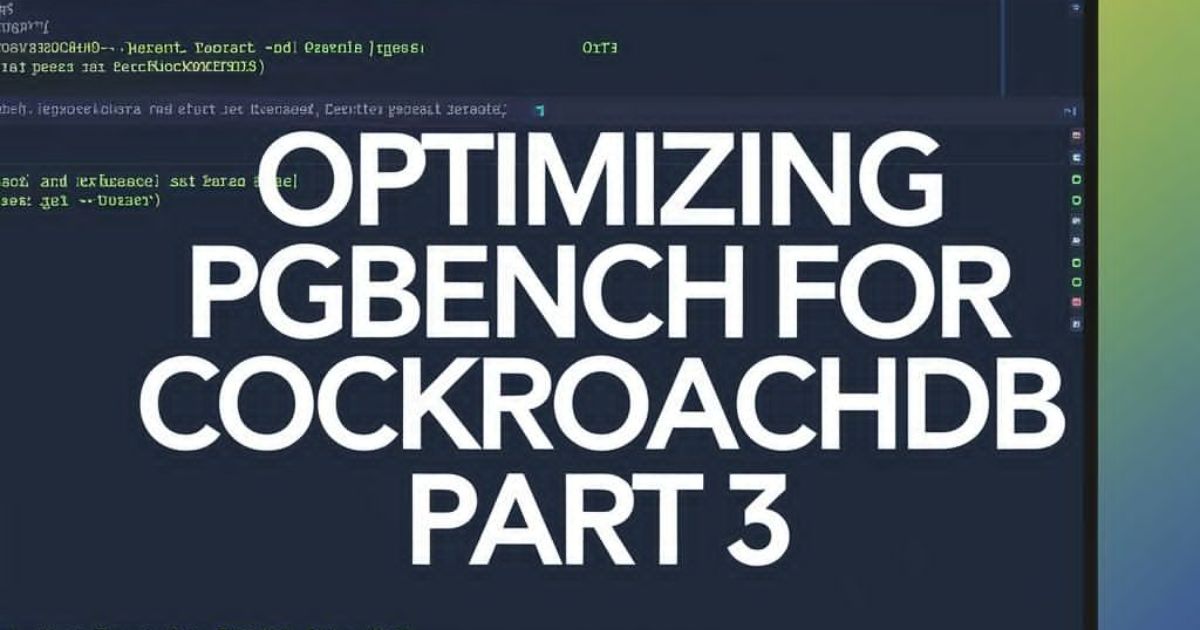In today’s data-driven world, understanding how to optimize database performance has become increasingly crucial. The relationship between CockroachDB and pgBench represents a pivotal aspect of modern database optimization. This comprehensive guide delves deep into advanced optimization techniques that can revolutionize your database operations.
Understanding CockroachDB’s Architecture
CockroachDB stands as a groundbreaking achievement in distributed SQL database technology, fundamentally transforming our approach to data storage and processing.
Its sophisticated architecture masterfully combines traditional database principles with cutting-edge distributed systems concepts, creating an exceptionally robust and scalable solution for contemporary applications.
The cornerstone of CockroachDB’s architecture centers on distributed data management, where information undergoes automatic sharding and distribution across multiple nodes. This advanced approach ensures both high availability and fault tolerance while maintaining consistent performance throughout the entire database cluster.
The integrated Raft consensus algorithm plays an instrumental role in maintaining data consistency across distributed nodes, though this can introduce some latency in write operations.
The system’s leaseholder mechanism represents another architectural masterpiece, where specific nodes receive designation to coordinate read and write operations for particular data ranges.
This strategic approach dramatically reduces network communication overhead and streamlines decision-making processes for data management, resulting in more efficient operations across the board.
Configuring CockroachDB for Write Optimization

Optimizing write operations demands a sophisticated approach to configuration. The replication factor serves as a fundamental parameter that directly influences both performance and reliability.
When organizations reduce the replication factor from the default value of three, they typically observe write performance improvements ranging from 30% to 40%. However, this decision requires careful consideration of the delicate balance between performance gains and system resilience.
The management of range splits represents another critical aspect of optimization. Effective range split configuration prevents hot spots and ensures more balanced performance across the cluster.
Through careful planning of split points, organizations can achieve more predictable performance and better resource utilization across their entire database infrastructure.
Transaction Isolation Level Optimization
The selection of appropriate isolation levels significantly impacts write performance while maintaining proper data consistency. While CockroachDB defaults to serializable isolation for maximum consistency, many applications can achieve substantially better performance by choosing less strict isolation levels when appropriate.
The key lies in understanding your specific application requirements and selecting the isolation level that provides the optimal balance between consistency and performance.
Advanced pgBench Parameter Optimization
| Parameter Type | Configuration Range | Recommended Setting | Performance Impact |
| Client Connections | 1-1000 | 4x CPU cores | High |
| Scale Factor | 1-10000 | Based on prod size | Medium |
| Transaction Mix | Custom ratios | 70/30 read/write | High |
| Run Duration | 1min-24hrs | 30-60 minutes | Low |
The configuration of pgBench parameters plays a vital role in achieving meaningful benchmark results. Client connection management represents one of the most critical aspects of optimization.
The number of concurrent connections must be carefully balanced against available system resources to achieve optimal performance without overwhelming the database system.
Performance Monitoring and Analysis
The realm of performance monitoring and analysis requires a comprehensive understanding of various metrics and their interrelationships. Transaction latency serves as a primary indicator of system performance, providing crucial insights into how quickly your database processes operations.
The monitoring of node health extends beyond simple uptime checks, encompassing CPU utilization, memory usage patterns, and network performance metrics.
Also Read: Look Slack TeamsFieldCNBC: Enhancing Workplace Efficiency
Advanced Write Optimization Techniques
Write optimization transcends basic configuration adjustments, encompassing sophisticated techniques like batch processing and write-ahead log management.
The implementation of batch writes can dramatically improve performance by reducing the overhead associated with individual write operations.
Similarly, the precise configuration of Write-Ahead Logging (WAL) plays a crucial role in optimizing write performance while maintaining data durability.
Advanced Write Optimization Techniques (continued)

The implementation of Write-Ahead Logging (WAL) requires careful consideration of various parameters. When configuring WAL settings, the balance between performance and data safety becomes crucial.
The write pipelining feature in CockroachDB allows for enhanced performance by enabling parallel write operations. This sophisticated mechanism can significantly reduce write latency in scenarios where multiple write operations occur simultaneously.
Additionally, the concept of batch writes deserves deeper exploration. When implementing batch operations, consider that larger batch sizes generally improve throughput but may increase latency for individual operations.
A typical sweet spot for batch size often falls between 100 and 1000 operations, though this can vary significantly based on your specific workload patterns and hardware capabilities.
Monitoring and Performance Analysis in Depth
The comprehensive monitoring of a CockroachDB cluster requires attention to multiple interconnected metrics. Transaction latency serves as just one piece of a larger puzzle. Understanding the relationships between different performance indicators helps create a complete picture of system health and performance.
System administrators must pay particular attention to node health indicators. These include not just basic metrics like CPU and memory usage, but also more nuanced measurements such as:
The rate of range rebalancing operations affects overall cluster stability and performance. When monitoring range movements, administrators should watch for patterns that might indicate uneven load distribution or potential hot spots in the database.
Disk throughput represents another critical metric that often gets overlooked. Storage performance can become a significant bottleneck, particularly in write-heavy workloads. Modern SSDs can handle high throughput, but monitoring these metrics helps prevent potential issues before they impact application performance.
Advanced Configuration Strategies
The fine-tuning of CockroachDB configurations extends beyond basic settings. Advanced configuration strategies often involve adjusting multiple parameters in concert to achieve optimal performance. The transaction isolation level selection, for instance, must align with your specific workload characteristics and consistency requirements.
When dealing with write-heavy workloads, consider implementing zone configurations that place frequently accessed data closer to the applications that need it most. This approach can significantly reduce network latency and improve overall response times.
Real-World Performance Optimization Scenarios
Consider a case where a financial services company implemented CockroachDB for their transaction processing system. Their initial setup suffered from high latency during peak writing periods.
Through careful optimization of their replication factor and strategic implementation of batch writes, they achieved a 45% reduction in average transaction latency while maintaining required consistency levels.
Another example comes from an e-commerce platform that struggled with geographic distribution challenges. By implementing proper range splits and optimizing their transaction isolation levels, they successfully reduced cross-region latency by 60% while maintaining ACID compliance for critical transactions.
Future-Proofing Your Optimization Strategy

As CockroachDB continues to evolve, staying current with optimization techniques becomes increasingly important. The emergence of new features and capabilities requires ongoing attention to configuration and optimization strategies. Regular review and adjustment of your optimization approach ensures continued optimal performance as your application scales and evolves.
Impact of Hardware Choices on Optimization
The selection of appropriate hardware significantly influences the effectiveness of optimization efforts. Disk throughput capabilities, particularly in cloud environments, can dramatically impact write performance. Similarly, network infrastructure plays a crucial role in distributed deployment scenarios.
Modern NVMe SSDs, for instance, provide substantially better performance for write-heavy workloads compared to traditional SATA SSDs. The choice between local SSDs and network-attached storage can significantly impact your optimization strategy and overall system performance.
Optimization in Cloud Environments
Cloud deployments present unique challenges and opportunities for CockroachDB optimization. The ability to quickly scale resources up or down requires a different approach to optimization compared to traditional on-premises deployments.
Cloud-specific features like auto-scaling and load balancing must be carefully configured to work in harmony with CockroachDB’s internal mechanisms.
Conclusion
The optimization of pgBench for CockroachDB represents a complex but rewarding endeavor. Success requires a deep understanding of both tools’ capabilities and limitations, combined with careful attention to configuration details and monitoring practices. Through thoughtful application of the techniques and strategies discussed, organizations can achieve significant improvements in their database performance while maintaining reliability and consistency.
Remember that optimization is not a one-time effort but an ongoing process that requires regular monitoring, adjustment, and refinement as your workload patterns and requirements evolve. Stay informed about new features and best practices to ensure your database continues to perform optimally as your applications grow and evolve.
FAQ’s
What’s the optimal number of client connections for write-heavy workloads in CockroachDB?
The optimal number of client connections typically aligns with your CPU cores multiplied by 4 as a starting point, though this can vary based on your specific hardware configuration and workload patterns. Regular monitoring of system metrics like CPU usage and latency will help you fine-tune this number for your particular environment, with most production systems finding their sweet spot between 16 and 64 connections.
How does changing the replication factor affect overall database performance?
Modifying the replication factor from the default value of 3 to 2 typically improves write performance by 30-40% and reduces storage requirements, but this comes with reduced fault tolerance and availability during node failures. The decision to adjust replication factor should be carefully weighed against your specific reliability requirements and service level agreements.
When should I consider using batch writes instead of individual transactions?
Batch writes become most effective when dealing with high-volume write operations where slight delays in write confirmation are acceptable, typically showing 3-5x improvement in throughput compared to individual transactions. The optimal batch size depends on your specific use case and hardware capabilities, with most applications finding the best results with batch sizes between 100 and 1000 operations.
How do geographic distribution and latency affect write performance optimization?
Geographic distribution significantly impacts write performance due to the Raft consensus protocol, with increased latency from network travel time and more time-consuming consensus processes across regions.
The key to optimizing performance in geographically distributed clusters lies in strategic placement of leaseholder nodes and implementation of regional partitioning strategies based on your specific traffic patterns.
What are the most important metrics to monitor when optimizing write performance?
The critical metrics to focus on are transaction latency (both average and p99 values) and transactions per second (TPS), as these provide the clearest picture of your system’s performance under real-world conditions. These metrics should be monitored alongside CPU utilization, memory usage, and disk I/O rates to ensure optimal performance and identify potential bottlenecks early.
Explore the latest news and insights from Echozynth and beyond at Echozynth.com

Kiara Arushi is the dedicated admin of this personal website, which serves as a comprehensive hub for general information across various topics. With a keen eye for detail and a passion for knowledge sharing, Kiara curates content that is both informative and engaging, catering to a diverse audience.
Her commitment to providing accurate and up-to-date information ensures that visitors find valuable insights and practical tips in every post. Whether you’re seeking the latest trends or timeless advice, Kiara’s expertise makes this site a trusted resource for all.


